ABBREVIATIONS
PK
sGC
NANC
NO
NOS
GI tract
VDCCL
GC
LC
ACh
SNP
TEA
KCa channel
KBC
L-NNA
ODQ
4-AP
KV channel
NBC
[Ca2+]i
ICC
Journal List > Korean J Physiol Pharmacol > v.16(5) > 1025816
PK
sGC
NANC
NO
NOS
GI tract
VDCCL
GC
LC
ACh
SNP
TEA
KCa channel
KBC
L-NNA
ODQ
4-AP
KV channel
NBC
[Ca2+]i
ICC
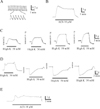 | Fig. 1Contractions of circular and longitudinal smooth muscle of the fundus greater curvature (GC). Circular muscle of the fundus GC showed spontaneous contraction (A). In (C) high-K+ produced an initial and a tonic contraction and it reached peak by stepwise stretch (0.8~1 g). ACh (10 µM) produced triphasic contractions in panel (B). Longitudinal muscle of the fundus lesser curvature (LC) obtained from a patient who underwent repetitive gastrectomy showed large high K+-induced relaxation (D). ACh produced contraction in the longitudinal muscle (E). |
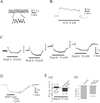 | Fig. 2High K+-induced relaxation of longitudinal smooth muscle in the fundus GC. Longitudinal muscle showed spontaneous (A) and ACh-induced contraction (B) however high K+ produced relaxation (C). High K+-induced relaxation was gradually increased by application of stepwise stretch (C). In (D) SNP (3 and 5 µM) produced relaxation of -3.0 g. High K+ produced relaxation (-1.4 g; Ea) and it was -61% of total relaxation to basal tone (Eb). |
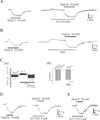 | Fig. 3Effect of inhibitors of K+ channels and protein kinases (PK) on high K+-induced relaxation of longitudinal smooth muscle in the fundus GC. High K+-induced relaxation was not inhibited by tetraethylammonium (TEA, 10 mM) which is known inhibitor of Ca2+-activated K+ channel (KCa channel) (A) and also not by K+ channel blockers cocktail (KBC except 4-AP, see methods; (B), (Ca, Cb). Furthermore, it was not affected by KT5823 and KT5720, blockers of PKG and PKA, respectively (D, E). |
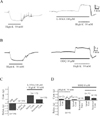 | Fig. 4Involvement of nitric oxide (NO) and soluble guanylyl cyclase (sGC) on high K+-induced relaxation of longitudinal smooth muscle in the fundus GC. In (A, B) high K+ produced relaxation in longitudinal muscle in the fundus GC. However, L-NNA (100 µM) and ODQ (10 µM) blocked and reversed high K+-induced relaxation to contraction (A, B). The data were summarized in (C, D). |
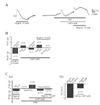 | Fig. 5Effects of 4-aminopyridine (4-AP) on high K+-induced relaxation of longitudinal smooth muscle in the fundus GC. Most high K+-induced relaxation were blocked or reversed to contraction (A), though some were not, by pretreatment of 4-AP with nerve blockers cocktail (NBC, see methods; C). In (B) effect of 4-AP (5 mM) on high K+-induced relaxation was summarized. In the presence of 4-AP (5 mM), high K+-induced relaxation was inhibited. In the presence of NBC and 4-AP, the percent relaxation of high K+-induced relaxation was suppressed (Ca) to -32% of the control (Cb). |
 | Fig. 6High K+-induced response in the fundus LC. Contractile properties of circular and longitudinal smooth muscles of the fundus LC were investigated too. Circular muscle of the fundus LC showed high K+-induced contraction (A). Meanwhile, high K+ produced an initial contraction followed by an weak contraction in longitudinal muscle of the fundus LC (B). |
PK
sGC
NANC
NO
NOS
GI tract
VDCCL
GC
LC
ACh
SNP
TEA
KCa channel
KBC
L-NNA
ODQ
4-AP
KV channel
NBC
[Ca2+]i
ICC